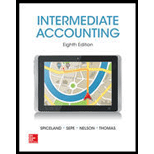
Concept explainers
(1)
Earnings per share (EPS): The amount of earnings made available to each common share is referred to as earnings per share. Dilutive securities like convertible bonds, convertible preferred stock, and stock options, reduce the EPS by increasing the common shares.
Use the following formula to determine EPS:
Net loss per share: The computation of EPS requires net income. But if a company reports net loss instead of net income, the loss which is generated by each common share, is referred to as net loss per share.
To determine: The net loss per share of Incorporation A for the year ended December 31, 2016
(1)
Explanation of Solution
Determine net loss per share of Incorporation A for the year ended December 31, 2016.
Step 1: Compute the amount of preferred dividends.
Note: Although the preferred dividend is not declared, the preferred dividends are deducted in the computation of EPS because the preferred shares are cumulative.
Step 2: Compute weighted average of purchase of
Step 3: Compute stock dividend shares on shares held on June 12, 2016.
Step 4: Compute stock dividend shares on weighted average treasury shares on April 30, 2016.
Note: Refer to Equation (2) for value and computation of number of treasury shares.
Step 5: Compute weighted average of treasury stock which were bought on April 30, 2016 and sold on August 31, 2016 (4 months).
Step 6: Compute the total weighted average number of common shares.
| Details | Number of Shares |
| Weighted average number of shares held on January 1, 2016 | 600,000,000 |
| Weighted average number of treasury stock bought on April 30, 2016 | (20,000,000) |
| Weighted average number of stock dividend shares distributed for shares held on January 1, 2016 | 30,000,000 |
| Weighted average number of stock dividend shares distributed for treasury shares bought on April 30, 2016 | (1,000,000) |
| Weighted average number of treasury stock sold on August 31, 2016 | 4,000,000 |
| Total weighted average number of shares | 613,000,000 shares |
Table (1)
Note: Refer to Equations (2) through (5) for value and computation of weighted average number of mentioned shares.
Step 7: Compute net loss per share of Incorporation A for the year ended December 31, 2016.
Note: Refer to Equation (1) for value and computation of preferred dividend amount, and Table (1) for value and computation of total weighted average number of shares.
(2)
The per share amount of income or loss from continuing operations of Incorporation A for the year ended December 31, 2016
(2)
Explanation of Solution
Determine per share amount of income or loss from continuing operations of Incorporation A for the year ended December 31, 2016.
Step 1: Compute the amount of loss from continuing operations.
Step 2: Compute per share amount of income (loss) from continuing operations of Incorporation A for the year ended December 31, 2016.
Note: Refer to Equation (1) for value and computation of preferred dividend amount, Equation (6) for income from continuing operations, and Table (1) for value and computation of total weighted average number of shares.
(3)
To prepare: A presentation to report EPS on the comparative income statements of Incorporation A, for the years ended December 31, 2015 and 2016
(3)
Explanation of Solution
Presentation of EPS:
| Incorporation A | ||
| Comparative Income Statements | ||
| For the Years Ended 2015 and 2016 | ||
| Particulars | 2016 | 2015 |
| Earnings per share: | ||
| Income from continuing operations | $0.16 | 0.71 |
| Loss from discontinued operations | (0.65) | 0 |
| Net income (loss) | $(0.49) | $0.71 |
Table (2)
Working Notes:
Calculate per share amount of loss from discontinued operations in 2016.
Compute earnings per share for 2015.
Note: Refer to Equation (3) for value and computation of stock dividend shares.
Want to see more full solutions like this?
Chapter 19 Solutions
INTERMEDIATE ACCOUNTING
- Golden Star Cafe had a 12% return on a $60,000 investment in new dining furniture. The investment resulted in increased sales and an increase in income that was 3% of the increase in sales. What was the increase in sales?arrow_forwardThe cash proceeds received by the seller are _______.arrow_forwardWhat was the cost of goods soldarrow_forward
- Caldwell Electronic Devices produces smartphone accessories. Estimated sales (in units) are 62,000 in July, 54,000 in August, and 49,500 in September. Each unit is priced at $35. Caldwell wants to have 45% of the following month's sales in ending inventory. That requirement was met on July 1. Each accessory requires 3 components and 8 feet of specialized cabling. Components cost $4 each, and cabling is $0.75 per foot. Caldwell wants to have 30% of the following month's production needs in ending raw materials inventory. On July 1, Caldwell had 45,000 components and 120,000 feet of cabling in inventory. What is Caldwell's expected sales revenue for August?arrow_forwardCalculate adjusted cost of goods soldarrow_forwardI need assistance with this financial accounting question using appropriate principles.arrow_forward

 AccountingAccountingISBN:9781337272094Author:WARREN, Carl S., Reeve, James M., Duchac, Jonathan E.Publisher:Cengage Learning,
AccountingAccountingISBN:9781337272094Author:WARREN, Carl S., Reeve, James M., Duchac, Jonathan E.Publisher:Cengage Learning, Accounting Information SystemsAccountingISBN:9781337619202Author:Hall, James A.Publisher:Cengage Learning,
Accounting Information SystemsAccountingISBN:9781337619202Author:Hall, James A.Publisher:Cengage Learning, Horngren's Cost Accounting: A Managerial Emphasis...AccountingISBN:9780134475585Author:Srikant M. Datar, Madhav V. RajanPublisher:PEARSON
Horngren's Cost Accounting: A Managerial Emphasis...AccountingISBN:9780134475585Author:Srikant M. Datar, Madhav V. RajanPublisher:PEARSON Intermediate AccountingAccountingISBN:9781259722660Author:J. David Spiceland, Mark W. Nelson, Wayne M ThomasPublisher:McGraw-Hill Education
Intermediate AccountingAccountingISBN:9781259722660Author:J. David Spiceland, Mark W. Nelson, Wayne M ThomasPublisher:McGraw-Hill Education Financial and Managerial AccountingAccountingISBN:9781259726705Author:John J Wild, Ken W. Shaw, Barbara Chiappetta Fundamental Accounting PrinciplesPublisher:McGraw-Hill Education
Financial and Managerial AccountingAccountingISBN:9781259726705Author:John J Wild, Ken W. Shaw, Barbara Chiappetta Fundamental Accounting PrinciplesPublisher:McGraw-Hill Education





